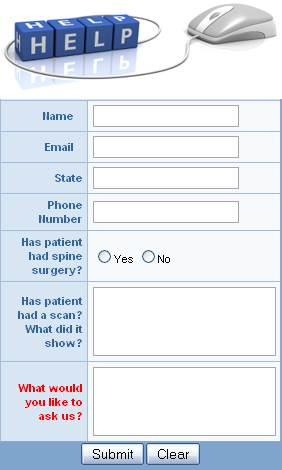Herniated Disc
- What is a herniated disc?
Herniated discs are often referred to as "slipped discs". This term derived from the action of the nucleus tissue when it is forced from the center of the disc. The disc itself does not slip. However, the nucleus tissues located in the center of the disc can be placed under so much pressure that it can cause the annulus to herniated or rupture against one or more of the spinal nerves which can cause pain, numbness, or weakness in the low back. leg or foot.
Other names used for herniated discs are "prolapsed", "bulging", "ruptured".
- Treatments for herniated discs.
Depending upon the results of the physical examination and the severity of your condition, your doctor may offer you two forms of treatment. The first common treatment is the aforementioned "Conservative Therapy," bed rest, pain medication, and physiotherapy. If conservative therapy does not bring enough pain relief, surgical procedures may be considered.
Until a few years ago, the only surgical treatment for herniated discs was the open removal of a part of the herniated disc, an often effective but major operation that requires general anesthesia, the dissection of muscle, removal of bone, and at times, bone fusion.
In recent years, techniques employing the use of endoscopy have been incorporated into lumbar spine surgery making minimally invasive spine surgery possible while overcoming disadvantages of traditional techniques. Non Traumatic Discectomy can provide an effective way to decompress and repair damages discs without open surgery.
An Endoscope provides clear visualization and magnification of deep structures. First used in knee surgery, endoscopy, (arthroscopy,) with its advanced miniaturization and video imaging technology has made it possible for a less invasive and less traumatic discectomy procedure for some disc patients.
- What is Non Traumatic Discectomy?
A Non Traumatic Discectomy is an outpatient procedure to physically remove the offending disc material. The procedure is performed in the operating room. Patients are administered local anesthesia, and also IV sedation is given by the anesthesiologist.
Then, with the help of x-ray fluoroscopy and a magnified video for guidance, a small specially designed endoscopic probe is inserted through the skin of the back, between the vertebrae and into the herniated disc space. Tiny surgical attachments are then sent down the hollow center of the probe to remove a portion of the offending disc. Sometimes, the microsurgical attachments can be used to push the bulging disc back into place and be used for the removal of disc fragments and small bone spurs which were causes sciatica and back problems
On average, the procedure takes about 45 minutes to an hour. X-ray exposure is minimal. You normally will feel little, if any, pain or discomfort. Upon completion, the probe is removed and a small Band-Aid is placed over the incision and back pain is relieved. There are no stitches.
The amount of nucleus tissue removed varies, and the supporting structure of the disc is not affected by the surgery. In comparison to large incisions required for open surgery, the access route to the disc in surgery consists of only the probe's small puncture site, usually the size of a freckle.
A Non Traumatic Discectomy is different from an open lumbar disc surgery because there is no traumatic back muscle dissection, no bone removal, and no large skin incision a non-traumatic discetomy is the next level past minimally invasive spine surgery . The risk of complications from scarring, blood loss, infection, and anesthesia that may occur with conventional surgery are drastically reduced or eliminated with this procedure. Non Traumatic Discectomy was invented to be an effective treatment for herniated discs and eliminated back pain while avoiding these risks.
Say No to Trauma with Minimally Invasive Spine Surgery for Herniated Disc with No Cutting, No Bleeding, No Scarring
|
|

|